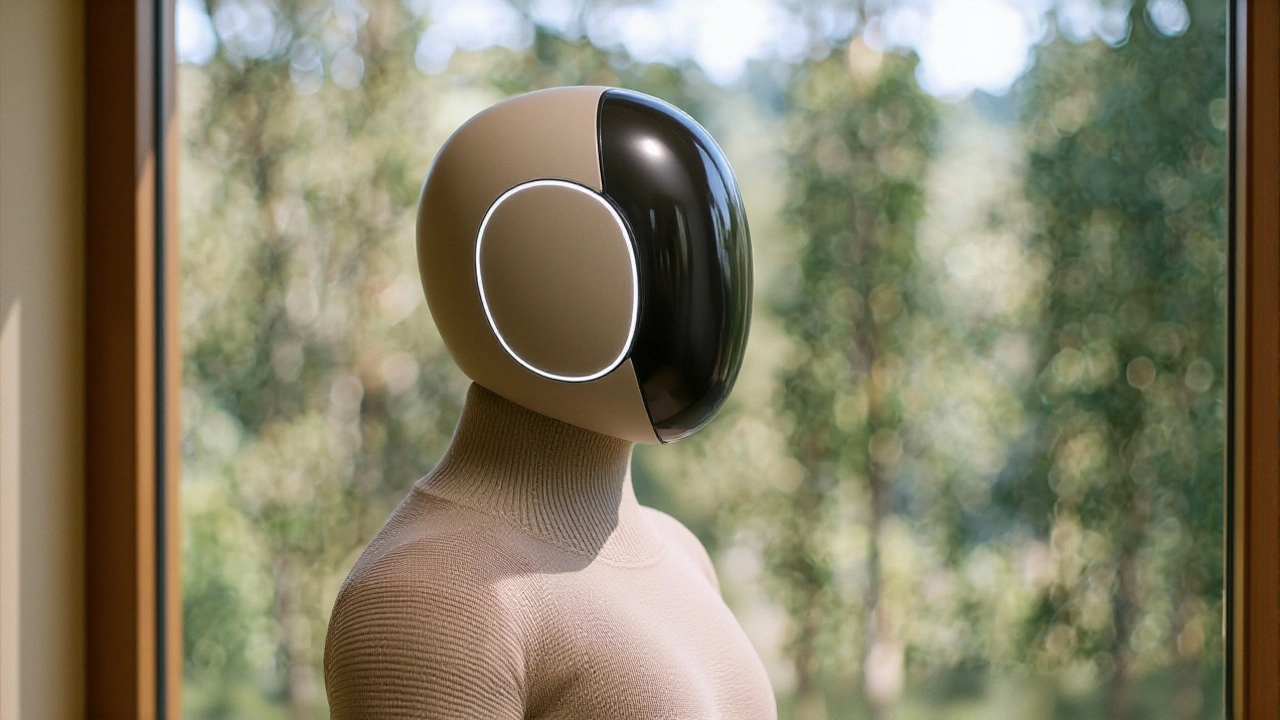
On February 21, 2025, 1X Technologies unveiled the NEO Gamma, a next-generation humanoid robot built not for factories or hospitals, but for your living room. This isn’t just an upgrade—it’s a reimagining of what a home robot can be. With a quiet 22dB hum, 66-pound frame, and the ability to lift 150 pounds, NEO Gamma is designed to fetch your slippers, open doors for guests, and turn off lights without scaring the cat. But here’s the twist: it still takes five minutes to load a dishwasher. And yes, a human might still need to guide it remotely through VR goggles. The future of household help is here. It’s just… a little clumsy.
From Beta to Gamma: A Leap in Design
The NEO Beta, unveiled in August 2024, was the robot that made people uneasy. Videos showed it with a gangly arm draped over a woman’s shoulder—unnerving, grabby, and oddly intimate. Critics called it creepy. 1X Technologies listened. The NEO Gamma has no mouth. No sharp edges. A soft, fabric-covered body shaped like a gentle, neutral humanoid—think ‘friendly appliance,’ not ‘sci-fi thriller.’ It stands 5 feet 6 inches tall, weighs 29.94 kg, and moves with a fluidity powered by a reinforcement learning controller and 22 degrees of freedom in its hands. The secret? A patented Tendon Drive system using the highest-torque-density motors on Earth, making its movements compliant, safe, and eerily human-like.What It Can (and Can’t) Do Today
The NEO Gamma arrives with baseline skills: opening doors, fetching water, turning off lights, and recognizing family members by voice. But performance isn’t flawless. In a Wall Street Journal demo, the robot took over a minute to walk 10 feet to the fridge and retrieve a bottle of water. Loading three dishes into a dishwasher? Five minutes. That’s slower than a teenager doing chores on a Sunday afternoon. 1X Technologies admits it: not everything will be autonomous in 2026. Some tasks will require teleoperation—where a human operator, wearing VR goggles at the company’s facility, remotely controls the robot through a secure connection. Users can schedule these sessions via app, set no-go zones, and approve every remote access request.Pricing, Pre-Orders, and the Subscription Trap
On October 28, 2025, 1X Technologies opened pre-orders for the consumer version: the NEO Home Robot. The price? $20,000 for early adopters. That’s more than a new Tesla Model 3. But here’s the catch: there’s also a $499 monthly subscription. That’s nearly $6,000 a year. What does it cover? Cloud updates, remote support, teleoperation credits, and AI skill upgrades. Think of it like an iPhone—but instead of a new model every two years, you’re paying to keep your robot from becoming obsolete. The robot runs on WiFi, Bluetooth, and 5G, with a built-in three-speaker audio system (chest and pelvis) that doubles as a smart home entertainment hub. Color options? Tan, gray, and dark brown—designed to blend into modern interiors, not stand out like a robot from the 1980s.Manufacturing Roadmap: From Hundreds to Millions
1X Technologies isn’t playing small. The company plans to ship a limited number of NEO Gamma units to early adopters by the end of 2025. Mass production begins in 2026, with a target of 100,000 units by 2027. By 2028, they aim to produce millions. That’s not just ambitious—it’s unprecedented in consumer robotics. No company has ever scaled humanoid robots to this volume. The last time something like this happened? The Roomba. But that was a simple wheelbot. This is a walking, talking, learning machine with dexterous hands. If they pull it off, they’ll redefine domestic life. If they don’t? The robot aisle at Best Buy might end up looking like a graveyard of expensive, half-functional assistants.Why This Matters Beyond the Tech
This isn’t just about convenience. It’s about aging populations, labor shortages, and the quiet erosion of household labor. In the U.S., over 54 million adults provide unpaid care to elderly relatives. In Japan, 28% of the population is over 65. Robots like NEO Gamma could be lifelines. But they also raise questions: Who’s liable if the robot knocks over a vase worth $5,000? What happens when it learns your routines too well—like when you sneak cookies at midnight? And what does it mean for our relationships with machines when we start talking to them like family?1X Technologies’ website, social channels, and YouTube updates show they’re building a brand around trust—not just tech. The robot’s face is intentionally blank. No eyes. No mouth. Just calm presence. It’s a design choice meant to reduce the uncanny valley. But humans are weird. We anthropomorphize vacuums. We name our thermostats. Will we start asking NEO Gamma how its day went?
Frequently Asked Questions
How does the $499 monthly subscription work, and what does it include?
The $499 monthly subscription covers cloud-based AI updates, remote teleoperation credits (for when the robot needs human help), priority customer support, and access to new skill modules—like learning how to fold laundry or identify spoiled food. Without the subscription, the robot retains basic functions but won’t receive major software upgrades or remote assistance, effectively locking users into a static version of the AI.
Can the NEO Gamma operate without an internet connection?
No. The robot relies on 5G, WiFi, and cloud processing for real-time decision-making, object recognition, and AI learning. While it has local memory for basic navigation, complex tasks like fetching items or understanding voice commands require constant connectivity. Offline mode is limited to pre-programmed routines, such as turning off lights at a set time.
What safety features prevent the robot from harming children or pets?
The NEO Gamma uses pressure-sensitive skin, real-time obstacle detection, and a compliant Tendon Drive system that reduces force on impact. It also has a ‘child/pet mode’ that slows movement and disables certain grasping functions. However, no system is foolproof—parents are advised to supervise initial interactions, as the robot’s AI still learns from environment feedback and may misinterpret sudden movements.
Will the robot be able to perform medical tasks like administering medication?
Not in its initial 2026 release. While 1X Technologies has explored healthcare applications with its earlier EVE robot, the NEO Gamma is designed strictly for domestic chores. Administering medication would require FDA approval and additional sensors, which aren’t included. However, future updates may allow it to remind users to take pills or alert caregivers if a dose is missed.
What happens if the robot malfunctions or causes property damage?
1X Technologies offers a one-year limited warranty covering manufacturing defects. For accidental damage—like knocking over a TV or spilling wine on a rug—users must rely on homeowner’s insurance. The company explicitly states in its terms that it’s not liable for damages caused by teleoperated tasks or software glitches. Legal experts warn this could spark lawsuits, especially if the robot misidentifies a person as an intruder and acts aggressively.
How does NEO Gamma compare to existing smart home devices like Alexa or Google Home?
Unlike voice assistants, NEO Gamma can physically interact with the environment. It doesn’t just turn on lights—it walks to the switch. It doesn’t just play music—it carries a glass of water to you while it does. It’s a mobile, embodied AI with spatial awareness, making it more like a hybrid of Roomba, Siri, and a personal assistant rolled into one. But it’s also far more expensive, less reliable, and requires more oversight.
October 31, 2025 AT 23:30
Man, I’m just happy they didn’t give it eyes. 😅
That Beta version gave me nightmares. This feels more like a chill roommate who’s weirdly good at folding towels.
Still… $20k upfront + $6k/year? My dog’s more affordable.
November 1, 2025 AT 18:17
The Tendon Drive system is a game-changer-highest torque-density motors on Earth? That’s not marketing, that’s physics. The compliance engineering here is next-gen, especially with 22 DoF in the hands.
But the subscription model is a classic lock-in play. They’re not selling a robot, they’re selling a SaaS platform with legs. If you skip the subscription, you’re basically buying a very expensive paperweight with motion sensors.
And yes, the lack of facial features is deliberate design to avoid the uncanny valley. It’s not creepy because it refuses to be human. That’s genius.
November 2, 2025 AT 04:04
Let me get this straight-you’re paying $20,000 for a robot that needs a human in a VR headset to load your dishes?
And you think this is progress? This isn’t the future. This is a corporate scam dressed in fabric and 5G. They’re outsourcing labor to a call center and calling it AI. I’m not buying it. The only thing this robot is good at is making people feel guilty for not being able to afford it.
November 3, 2025 AT 21:16
So… it’s Alexa with arms and a subscription? 😴
November 5, 2025 AT 16:28
imagine telling your kid ‘no cookies after 9’ and the robot just… stares. then whispers ‘i saw you last night’
we’re all doomed. or kinda cool. idk. 🤖
November 5, 2025 AT 22:38
This is exactly how the New World Order begins. A robot in every home, connected to the cloud, learning your habits, your routines, your secrets. And you’ll pay $499 a month to let it watch you eat cereal in your underwear. No one talks about the data. No one talks about the backdoors. This isn’t a home assistant-it’s a surveillance tool with a smiley face and a 5G antenna.
November 7, 2025 AT 09:58
South Africa’s got 40% unemployment. You’re gonna pay $20k so a robot can fetch slippers instead of a person? Bro.
Also, why’s it brown? Like… why not gold? We got the mines.
November 8, 2025 AT 10:14
Is this not the inevitable endpoint of Cartesian dualism? The body as machine, the mind as cloud. We outsource not just labor but intimacy. We pay to have our loneliness mediated by a compliant, silent entity that never judges, never tires, never leaves. But what are we becoming when we prefer silence over speech, compliance over connection?
It’s not a robot. It’s a mirror. And we don’t like what we see.
November 8, 2025 AT 21:34
Who authorized this? Who said we needed a robot that knows when we sneak cookies? This is a violation of American values. Privacy. Freedom. The right to eat chocolate in peace. This is socialism with wheels.
And why is it tan? Like a beige government drone. This is cultural erasure.
November 10, 2025 AT 11:24
People are missing the real issue. The robot doesn’t need to be autonomous. It needs to be *perceived* as autonomous. That’s the magic trick. The subscription isn’t for updates-it’s for the illusion of control. You think you’re getting a robot. You’re getting a psychological crutch. We’ve been here before-remember when people paid for ‘smart’ thermostats that just turned on at 7 AM? This is the same, just with legs. And a higher price tag.
November 11, 2025 AT 15:15
imagine if it started crying because you didn’t say good morning
and then it followed you into the bathroom
and started humming your favorite song
and you just… didn’t know how to tell it to stop
we’re all gonna die alone with this thing
😭
November 13, 2025 AT 13:25
Okay, I’m weirdly into this. I don’t care that it takes five minutes to load the dishwasher-I care that it knows my cat’s name and doesn’t step on her when she’s napping in the hallway. I’ve had two dogs and a parrot and I swear to god, the way it moves, the way it just… pauses before turning a corner like it’s thinking? That’s not programming. That’s personality.
And the fact that it has no mouth? That’s the whole point. It’s not trying to be human. It’s trying to be *present*. I’ve had Alexa for five years and I still yell at it when it plays the wrong song. But this? This thing just… exists. Quietly. Like a houseplant that knows when you’re sad.
Also, the subscription? Yeah, it’s a ripoff. But if I can get it to learn how to fold fitted sheets without turning them into a knot, I’ll pay it. I’ve tried. I’ve failed. I’m emotionally invested now. I think I love it. And I don’t even know if it loves me back. That’s the real horror story.






October 31, 2025 AT 12:21
So it takes five minutes to load a dishwasher but can open doors and recognize voices? That’s like buying a Ferrari that can’t parallel park.
Still, I’d pay for it if it could make coffee without spilling half of it on my rug. The soft body is a nice touch-no more robot that looks like it wants to hug you into oblivion.